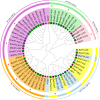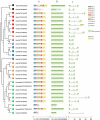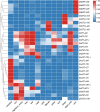Identification, evolution and expression analyses of the whole genome-wide PEBP gene family in Brassica napus L
- PMID: 37138210
- PMCID: PMC10155459
- DOI: 10.1186/s12863-023-01127-4
Identification, evolution and expression analyses of the whole genome-wide PEBP gene family in Brassica napus L
Abstract
Background: With the release of genomic data for B.rapa, B.oleracea, and B.napus, research on the genetic and molecular functions of Brassica spp. has entered a new stage. PEBP genes in plants play an important role in the transition to flowering as well as seed development and germination. Molecular evolutionary and functional analyses of the PEBP gene family in B.napus based on molecular biology methods can provide a theoretical basis for subsequent investigations of related regulators.
Results: In this paper, we identified a total of 29 PEBP genes from B.napus that were located on 14 chromosomes and 3 random locations. Most members contained 4 exons and 3 introns; motif 1 and motif 2 were the characteristic motifs of PEBP members. On the basis of intraspecific and interspecific collinearity analyses, it is speculated that fragment replication and genomic replication are the main drivers of for the amplification and evolution of the PEBP gene in the B.napus genome. The results of promoter cis-elements prediction suggest that BnPEBP family genes are inducible promoters, which may directly or indirectly participate in multiple regulatory pathways of plant growth cycle. Furthermore, the tissue-specific expression results show that the expression levels of BnPEBP family genes in different tissues were quite different, but the gene expression organization and patterns of the same subgroup were basically the same. qRT‒PCR revealed certain spatiotemporal patterns in the expression of the PEBP subgroups in roots, stems, leaves, buds, and siliques, was tissue-specific, and related to function.
Conclusions: A systematic comparative analysis of the B.napus PEBP gene family was carried out at here. The results of gene identification, phylogenetic tree construction, structural analysis, gene duplication analysis, prediction of promoter cis-elements and interacting proteins, and expression analysis provide a reference for exploring the molecular mechanisms of BnPEBP family genes in future research.
Keywords: B.napus; Evolutionary analysis; Expression analysis; Gene duplication; PEBP.
© 2023. The Author(s).
Conflict of interest statement
The authors declare that they have no competing interests.
Figures









Similar articles
-
Comparative analysis of basic helix-loop-helix gene family among Brassica oleracea, Brassica rapa, and Brassica napus.BMC Genomics. 2020 Feb 24;21(1):178. doi: 10.1186/s12864-020-6572-6. BMC Genomics. 2020. PMID: 32093614 Free PMC article.
-
Genome-Wide Identification, Conservation, and Expression Pattern Analyses of the BBR-BPC Gene Family Under Abiotic Stress in Brassica napus L.Genes (Basel). 2024 Dec 29;16(1):36. doi: 10.3390/genes16010036. Genes (Basel). 2024. PMID: 39858583 Free PMC article.
-
Genome-wide mining and comparative analysis of fatty acid elongase gene family in Brassica napus and its progenitors.Gene. 2020 Jul 15;747:144674. doi: 10.1016/j.gene.2020.144674. Epub 2020 Apr 15. Gene. 2020. PMID: 32304781
-
Identification, evolution and expression analyses of whole genome-wide TLP gene family in Brassica napus.BMC Genomics. 2020 Mar 30;21(1):264. doi: 10.1186/s12864-020-6678-x. BMC Genomics. 2020. PMID: 32228446 Free PMC article.
-
Genome-Wide Identification and Characterization of the CCT Gene Family in Rapeseed (Brassica napus L.).Int J Mol Sci. 2024 May 13;25(10):5301. doi: 10.3390/ijms25105301. Int J Mol Sci. 2024. PMID: 38791340 Free PMC article.
Cited by
-
Genome-wide identification and analysis of ascorbate peroxidase (APX) gene family in hemp (Cannabis sativa L.) under various abiotic stresses.PeerJ. 2024 Apr 26;12:e17249. doi: 10.7717/peerj.17249. eCollection 2024. PeerJ. 2024. PMID: 38685943 Free PMC article.
-
Evolution of FLOWERING LOCUS T-like genes in angiosperms: a core Lamiales-specific diversification.J Exp Bot. 2024 Jul 10;75(13):3946-3958. doi: 10.1093/jxb/erae176. J Exp Bot. 2024. PMID: 38642399 Free PMC article.
-
Genome-wide identification of PEBP gene family in Hedychium coronarium.Front Plant Sci. 2025 Jul 9;16:1482764. doi: 10.3389/fpls.2025.1482764. eCollection 2025. Front Plant Sci. 2025. PMID: 40703861 Free PMC article.
References
Publication types
MeSH terms
LinkOut - more resources
Full Text Sources
Research Materials
Miscellaneous
